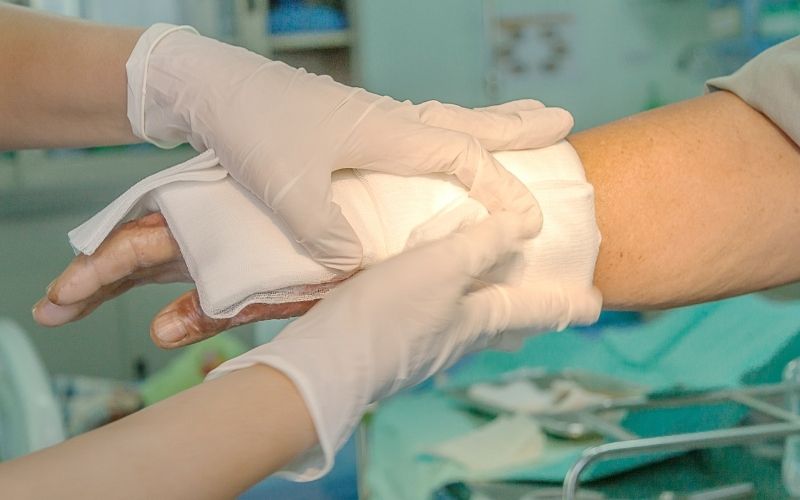Burns happen by indirect or direct contact with chemical agents, electric current, heat, or radiation. Burns can lead to the death of your cells, can require hospitalization, and can also sometimes be fatal. If you have suffered a burn, an Atlanta burn injury lawyer may be able to help your case.

Levels of Burns
There are three different layers of burns.
First Degree: These burns are on the outer layer of the skin but can cause swelling, pain, and redness.
Second Degree: These burns affect both the underlying layer and outer layer of the skin and can cause swelling, redness, and pain, in addition to blistering.
Third Degree: These burns go into the deeper layers of the skin and are also known as full-thickness burns. They cause blackened or white skin, and the skin could be bumpy.
Minor burns are first-degree or second-degree ones that are less than three inches wide. Major burns include second-degree burns bigger than three inches or ones on the groin, face, feet, or hands, and all third-degree burns. It’s possible to have more than one type of burn, especially if a large area of the body has suffered from burns. Any major burns will need medical attention right away in order to help prevent deformity, disability, and scarring. Burns on the genitals, feet, hands, and face can be serious. Those over 60 and under age 4 have a higher chance for issues related to burns since the skin can be thinner than other age groups.
Causes of Burns
The most common causes of burns are flame, fire, scalding from hot liquids or steam, touching hot objects, chemical burns, and electrical burns. Burns can happen from industrial and house fires, accidents, playing with matches, faulty furnaces, industrial equipment, or heaters, unsafe use of fireworks or firecrackers, and kitchen accidents. Burns can also be due to sunlight and other sources of radiation, such as tanning beds, chemicals such as gasoline, paint thinner, lye, or strong acids, or abuse.
Prevention of Severe Burns
Even though there are many different causes of burns, there are ways to prevent them. Never leave anything on the stove unattended and keep the pot handles facing the back of the stove. Don’t hold a child while cooking on the stove and keep any hot liquids out of reach of pets and children. When cooking, don’t wear loose-fitting clothes that could easily catch fire. If children are present, block access to any heat sources, such as fireplaces, grills, stoves, and space heaters. Keep electrical safety in mind and keep wires and cords out of the way so children can’t play with them. Cover any electrical outlets, not in use with safety caps. Unplug curling irons or similar devices when not in use. Be sure you have working smoke detectors in each room and on every floor of the home and check the batteries. Keep fire extinguishers on every floor of the house. Set the thermostat for your water temperature below 120 degrees in order to prevent scalding.
Seeking Medical Attention for Burns
There are many different burns that require medical help. Go to the local emergency room or call 911 if the burn is third-degree and severe, or it’s larger than the size of your palm. Also, seek attention if burns are caused by electricity or chemicals, or the person is showing signs of sock. If the suspected or known cause of the burn is physical abuse, it’s also important to seek help. If a fire was the cause of the burn, the person could have breathed in smoke and needs additional medical attention. Other symptoms associated with the burn, especially shock, should also be treated as a medical emergency. For minor burns, it’s important to check in with a healthcare provider if there is still pain after 48 hours or if there are signs of infection. Signs of infection include fever, increased pain, draining, swollen lymph nodes, or red streaks coming from the burn. Signs of dehydration associated with a burn are also important to pay attention to. These signs include thirst, nausea, lightheadedness, headache, dizziness, dry skin, or decreased urination. Older people, anyone with a weakened immune system, and children should be seen right away, regardless of how severe the burn is. Tests could include breath and airway support, urine and blood tests, chest X-ray for face burns, and ECG if complications or shock are present.
Treatment for Severe Burns
Treatments will depend on the severity of the burn, extent, and location. These can include intravenous fluids, medicines to prevent infection and pain relief, creams and ointments applied, and tetanus shots if your records are not up to date. Treatment will also depend on if there is another trauma that has occurred or internal organs that have been affected. Burns can lead to permanent scars and cause the skin to be more sensitive to temperature. Sensitive areas, such as the nose, eyes, or ears, can be badly injured by burns and lose normal function. If there is an airway burn, a person may have permanent lung damage and reduced breathing capacity. Severe burns can also affect the joints and leave you with decreased movement or function.